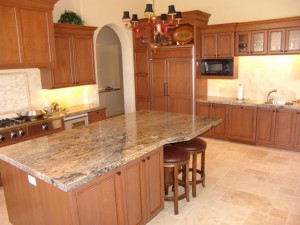 What should you look for with a natural stone countertop?
What should you look for with a natural stone countertop?
What’s the difference between marble and granite?
Although both are stones and both are quarried from the earth, granite and marble (and marble’s relatives – limestone, onyx and travertine) are very different from each other. Granite is formed deep in the earth’s mantle at extremely high temperatures, and is a very hard, resistant stone made of crystallized minerals.
The marble family – limestone, travertine, marble, onyx – starts out as sediment – animal skeletons and shells, plant matter, silt – at the bottom of bodies of water. After millions of years this solidifies (lithifies) into stone. Because its main component is calcium, it can be affected by acids such as vinegar and citrus beverages.
Is it necessary to seal stone?
All stone, even granite, is porous to some degree, and will absorb stains over time. Some stones are more porous than others, so it is important to use a penetrating sealer to prevent stains from oil, wine, or other liquids from soaking into the surface.
Do I have to buy the whole sheet/slab?
Slabs are always sold intact. Buying random slabs is similar to buying fabric. Like a seamstress or tailor, your fabricator buys the raw material and sells you a completed installation. In the price is included the cost of transporting the material, making field measurements and templates, cutting, polishing, bringing the pieces to your job site and fitting them into place. How much material he needs is determined by the layout and the amount of waste. The fabricator will lay out your job in a way that will minimize the amount of waste material while maximizing the natural beauty of veining and pattern.
Granite
What is granite?
The term “granite” is used to cover a group of related stones, all of which have their origin deep in the earth’s molten mantle. As this extremely hot liquid material rises and cools, it forms a crystalline, granular structure, hence the term granite. Granite and other granite-like stones are formed of hard minerals such as quarts, feldspar and mica, which are fused together into a very hard stone ideal for kitchen counters because its polish is resistant to household acids such as citrus and vinegar and is hard enough to resist scratching from knives and pots and pans.
Why is granite good for kitchen counters?
Because granite is very hard stone that’s formed at very high temperatures deep in the earth, its polish is not subject to etching by household acids, or scratching by knives and pots and pans. It’s unaffected by typical kitchen heat such as hot pans, or spilled liquid.
Can granite be damaged?
Like any solid surface, high impact blows can harm granite. Because of its crystalline structure, it can chip if subjected to sharp hard objects. Unsealed, granite can absorb stains such as oil, which can ultimately cause dark spots or discoloration. Heat from pots and pans or burning liquids will not affect granite under normal circumstances.
What is honed granite?
Strictly speaking, granite is called “honed” when the polishing process is halted just before a reflective shiny surface is achieved. This gives a softer, matte appearance to the stone.
My little sample of granite has pits on the surface – will I have these on my kitchen counters?
Granite, which is crystalline in structure, always has tiny pits – spaces between the various mineral crystals. You don’t see them on a larger piece because the overall appearance is polished and mirror-like. Granite sometimes has natural fissures as well, which may look like cracks, but are not structural defects and are a naturally occurring result of the immense heat and pressure which formed the granite eons ago. These characteristics are part of the natural beauty of stone and will not impair the function or durability of the material. A product of nature cannot be expected to look manmade.
Can I cut on my granite countertop?
Only if you want to ruin your good knives. Granite is harder than your knife blades and will dull them very quickly, if you use the countertop as a cutting surface. Always cut and chop on a wooden or plastic cutting board.
Marble
Can I use marble on my kitchen counters?
Yes. In fact, marbles that have a honed finish will not etch because its surface starts out with a matte finish. Because marbles (and limestone and travertine) are calcium carbonate, the polished surface is more vulnerable to household acids including vinegar, mustard, catsup, citrus and a host of other food-related products. These acidic substances cause a chemical reaction which will remove the polish.
Additionally, marble and limestone can be scratched more easily than harder stones such as granite. Marble is, however, sometimes used in the kitchen as a pastry slab; its perfectly smooth, cool surface is ideal for rolling out dough and piecrusts.
What is marble?
True geological marble is limestone that has been subjected to great pressure and heat, which has changed its structure to a crystalline, sugary texture. It is generally white or whitish, sometimes translucent, with some veining or color provided by other minerals present at its formation. White Carrara, Thassos, Colorado Yule and Bianco Rosa are true marbles.
Commercially, the term “marble” applies to any compact limestone that will take a polish, which includes most of the colored marbles, except some of the greens.
Does green marble require special treatment?
Some green stones, such as the “jades” from Taiwan, are not truly marble, but a different material called serpentinite. Serpentinites, or serpentines, as they are sometimes called, do not etch or react to acids the way limestone and marble do, and are somewhat harder.
What is honed marble or limestone and where is can it be used?
Marble, travertine, or limestone that is honed has a matte or satin finish, rather than a high reflective polish. This is achieved at the factory by stopping just short of the last stage of polishing. It is preferred by some because it has a less formal, softer appearance than polished stone.
What is etching?
Etching happens when acid in some form comes in contact with a polished marble or limestone surface. This causes a chemical reaction which removes the polish, or roughens the surface of honed marble or limestone. Green marbles, such as the “jades” from China are resistant to etching, and granite is impervious to any common household acids.
What’s the best way to clean marble and other stones? The old rule of thumb is never to use anything you wouldn’t use on your hands. Never use powdered cleansers or abrasive pads to clean your stone. Even “soft scrub” type cleaners contain pumice, which is powdered volcanic stone, and might damage your stone countertops or floors. Never use any product which is acidic; this includes substances like ammonia or many common liquid cleaners such as WindexTM.You should always use sealers and cleaning products designed specifically for natural stone.
Limestone
What is limestone?
Limestone is sedimentary rock consisting mostly of organic material such as skeletons and shells of marine creatures and sediments. It is formed by material which settles to the bottom of bodies of water, and over millions of years, solidifies (lithifies) into solid rock. Earth movements over extremely long periods of earth’s history can lift limestone miles into the air. The summit of Mount Everest is limestone that started out on an ocean floor.
Can I use limestone in my kitchen?
Like marble, polished limestone is subject to surface changes or damage from kitchen acids including citrus juices, vinegars, mustards, and so forth. Unsealed, some of the more porous limestones can be subject to stains. If the limestone is polished or semi-polished, you will see a rough spot where the substance sat on the stone. On a honed surface, such etches will be less noticeable.
Is limestone soft and chalky?
No, not at all. There are some limestones such as Beauharnais that are very hard and dense, nearly as hard and resistant as granite, and extremely non-porous. Keep in mind, though, that these very hard limestones are still calcium-based and, if polished, are subject to damage from household acids.
Travertine/Onyx
What is travertine? Is travertine the same as limestone?
Travertine is limestone, in a sense. It is formed by geysers, like Old Faithful, when the extremely hot underground water dissolves the underlying limestone and carries it upwards with the geyser water. When the water falls to the ground and evaporates, it leaves behind the dissolved limestone which re-hardens into stone. Like Calistoga™ or Perrier™ waters, the new stone is full of gas bubbles, which give travertine its characteristic appearance. When it is manufactured as tiles or slabs, travertine is generally filled with cement and polished or honed.
What is onyx?
Onyx, like travertine, is the result of water dissolving existing limestone and re-depositing it as a new kind of stone, sometimes called sinter. In limestone caves, onyx is formed by drip water, as stalagmites and stalactites. It is a very soft stone, and somewhat brittle, and needs to be installed where it will not be subject to hard wear. This beautiful stone is characterized by its translucence, and can actually be backlit for striking, dramatic effects.
